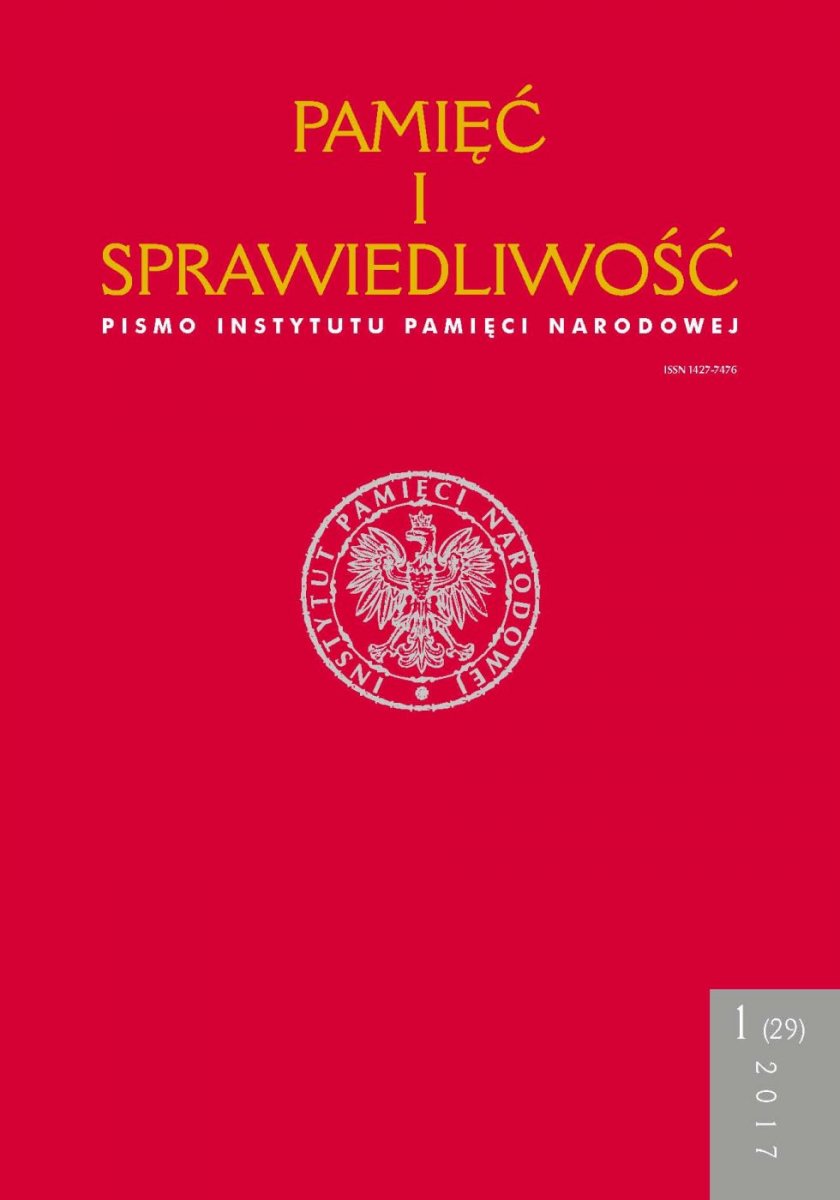Litwin-katolik? Witold Wielki i św. Kazimierz jako bohaterowie narodowi w litewskiej prasie niezależnej 1972–1988
Pamięć i Sprawiedliwość, V. 29 N. 1 (2017), pages: 219-235
Publication date: 2017-06-30
Abstract
Riferimenti bibliografici
Ališauskasm Vytautas (red.), Dzieje chrześcijaństwa na Litwie, Warszawa: PIW, 2014.
Aničas, Jonas. Klerikalinis antikomunizmas ir „lietuvio kataliko” koncepcija [Klerykalny antykomunizm i koncepcja „Litwina-katolika”], „Literatūra ir menas”, 1982 gegužės 1.
Aničas, Jonas. Klierikalinis ekstremizmas (medžiaga lektoriui) [Ekstremizm klerykalny (materiał dla lektora)], Vilnius: Žinija, 1985.
Aničas, Jonas. Socialinis politinis katalikų bažnyčios vaidmuo Lietuvoje 1945-1952 metais [Społeczno-polityczna rola Kościoła katolickiego na Litwie w latach 1945-1952], Vilnius: Pergale, 1971.
Bagušauskas, Juozapas R., A. Streikus. Arūnas, (red.) Lietuvos kultūra sovietinės ideologijos nelaisvėje 1940-1990. Dokumentų rinkinys, Vilnius: LGGRTC, 2005.
Baranauskas, Balys, Genovaitė Erslavaitė. Žudikai bažnyčios prieglobstyje [Mordercy pod skrzydłami kościoła (sic!)]. Vilnius: Valstybinė politinės ir mokslinės literatūros leidykla 1960.
Czarnowski, Stefan. Kult bohaterów i jego społeczne podłoże. Święty Patryk jako bohater narodowy Irlandii, Warszawa: PWN, 1956.
Dementavičius, Justinas et al. (red.), Lietuvos politinės minties antologija III. Politinė mintis Lietuvoje 1940-1990, Vilnius: VU leidykla, 2013.
Eidintas, Alfonsas et al. A. Bumblauskas, A. Kulakauskas, M. Tamošaitis, Historia Litwy, Wilno: Eugrimas, 2013.
Jaseliūnas, Egidijus. Krikšto jubiliejaus atgarsiai pogrindinėje savilaidoje, w: A. Streikus (red.), Katalikai ir valdžios XX amžiuje, Vilnius: Lietuvos katalikų mokslo akademija, 2007.
Jaseliūnas, EgidijuS. Savilaidos modelis ir Molotovo-Ribbentropo pakto dokumentų sklaidos atvėjis, „Knygotyra“, nr. 51, 2008.
Katalikų kalendorius-žinynas, 1984 (A), Kaunas: Lietuvos vyskupų konferencija, 1984.
Kubik, Jan. The Power of Symbols aganist the Symbols of Power. The Rise of Solidarity and the Fall of State Socialism in Poland, University Park: The Pennsylvania State UP, 1984.
Mačiulis, Dangiras, Rimmvydas Petrauskas, Darius Staliūnas, Kas laimėjo Žalgirio mūšį? Istorinio paveldo dalybos Vidurio ir Rytų Europoje, Vilnius: Mintis, 2012.
Maslauskaitė, Sigita. Królewicz Kazimierz, patron Polski i Litwy – święty władca, „Politeja. Studia litewskie“, 2011, nr. 2(16).
Maslauskaitė-Mažylienė, Sigita. Dzieje wizerunku św. Kazimierza od XVI do XVIII wieku. Między ikonografią a tekstem, Vilnius: Vilniaus dailės akademija, 2013.
Mickūnaitė, Giedrė. Making a Great Ruler. Grand Duke Vytautas of Lithuania, Budapest: CEU Press, 2006.
Mikłaszewicz, Irena. Polityka sowiecka wobec Kościoła katolickiego na Litwie 1944-1965, Warszawa: Instytut Studiów Politycznych PAN, 2001.
Nikžentaitis, Arvydas. Witold i Jagiełło. Polacy i Litwini we wzajemnym stereotypie, Poznań: Poznańskie Towarzystwo Przyjaciół Nauk, 2000.
Patackas, Algirdas. Pastogės Lietuva. Pogrindžio, Sąjūdžio ir Laisvės kronika, Vilnius: Aidai, 2011.
Putinaitė, Nerija. Nugenėta pušis. Ateizmas kaip asmeninis apsisprendimas tarybų Lietuvoje, Vilnius: Naujasis Židinys, 2015.
Račkauskaitė, Živilė. Pasipriešinimas sovietiniam režimui Lietuvoje aštuntajame dešimtmetyje, „Genocidas ir rezistencija”, 1999, 2 (6).
Rūpintojėlis. Pilnas 1977-1990 m. pogrindyje išleistų numerių (1-26) rinkinys, Kaunas: Judex, 2000.
Smith, Anthony D. Chosen Peoples. Sacred Sources of National Identity, Oxford UP 2003.
Streikus, Arūnas. Antykościelna polityka władzy sowieckiej na Litwie (1944-1990), Kraków: Rafael, 2010.
Streikus, Arūnas. Sovietų valdžios pastangos sužlugdyti Lietuvos krikšto jubiliejaus minėjimą, w: A. Streikus (red.), Katalikai ir valdžios XX amžiuje, Vilnius: Lietuvos katalikų mokslo akademija, 2007.
Šidlauskas, Gintaras, Lietuvos laisvės lyga: nuo „Laisvės šauklio“ iki nepriklausomybės, Vilnius: Naujoji matrica, 2006.
Vasiliauskaitė, Vilma. Tautinė ir liberalioji pogrindžio spauda Lietuvoje, 1976-1981, Vilnius: Gairė, 2000.
Veščikovas, Aleksandras. Tarybiniai įstatymai apie religinius kultus [Sowieckie przepisy o kultach religijnych], Vilnius: Valstybinė politinės ir mokslinės literatūros leidykla, 1963.
Viliūnas, Giedrius. Vytauto Didžiojo kultas tarpukario Lietuvoje, w; „Lietuvių atgimimo istorijos studijos“, t. 17 „Nacionalizmas ir emocijos (Lietuva ir Lenkija XIX-XX a.)”, Vilnius: Lietuvos istorijos institutas, 2001.
Vytauto Didžiojo jubiliejus, „Tautos kelias“, nr 1, 1982 (Chicago: Pasaulio lietuvių bendruomenė).
Wołowski, Paweł, Korzeniewska, Katarzyna. Jak służąc Panu Bogu przechytrzyć KGB. Rozmowy z twórcami „Kroniki Kościoła Katolickiego na Litwie”, Warszawa: Rhetos, 2006.
 Język Polski
Język Polski
 English
English
 Deutsch
Deutsch
 Français (France)
Français (France)
 Italiano
Italiano
 Русский
Русский


 PDF (Język Polski)
PDF (Język Polski)
